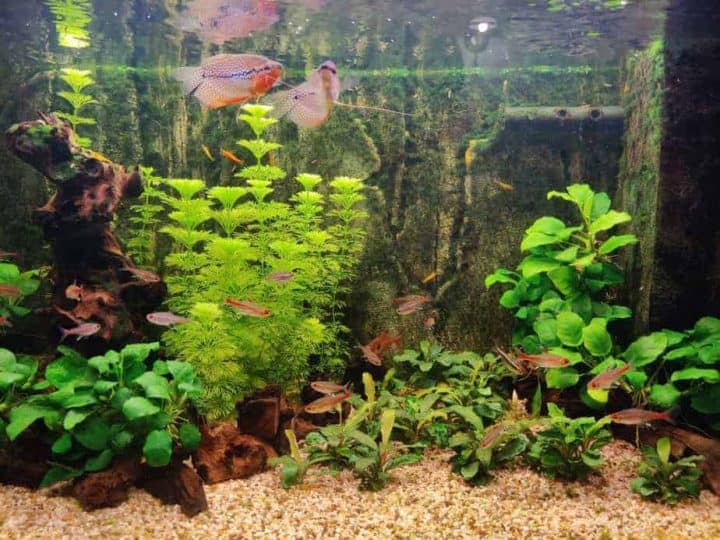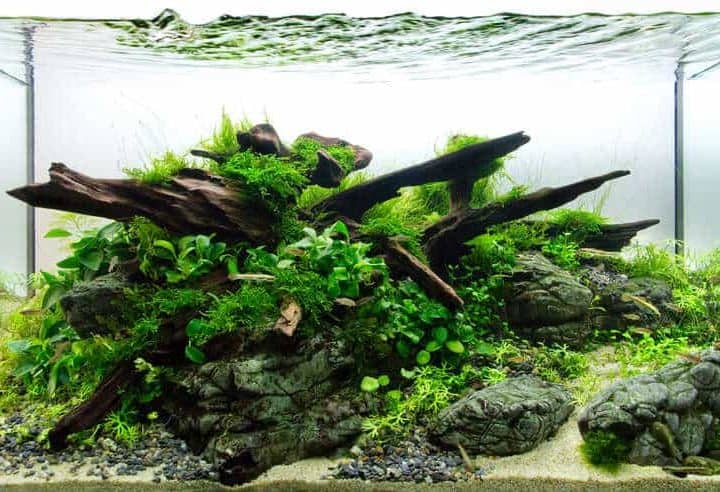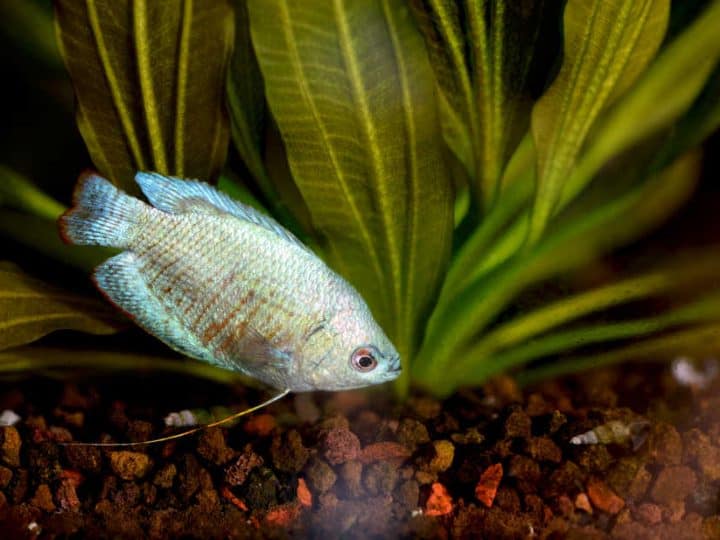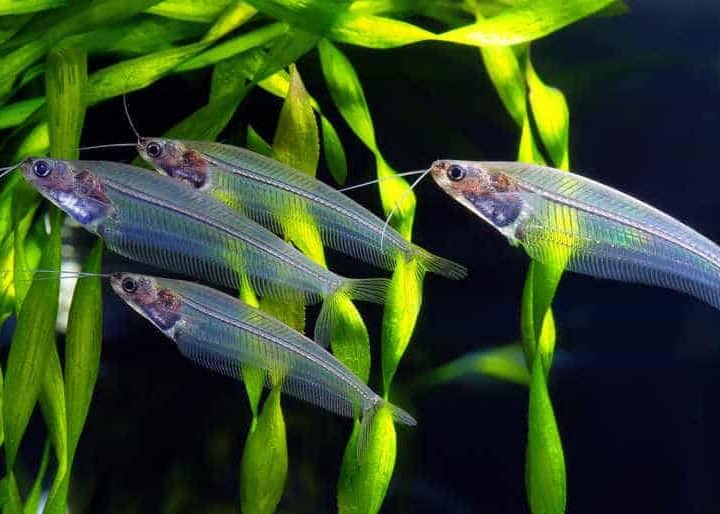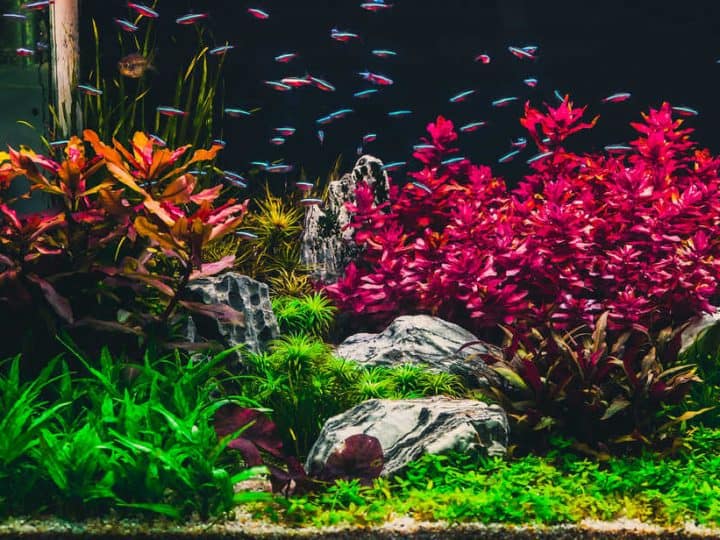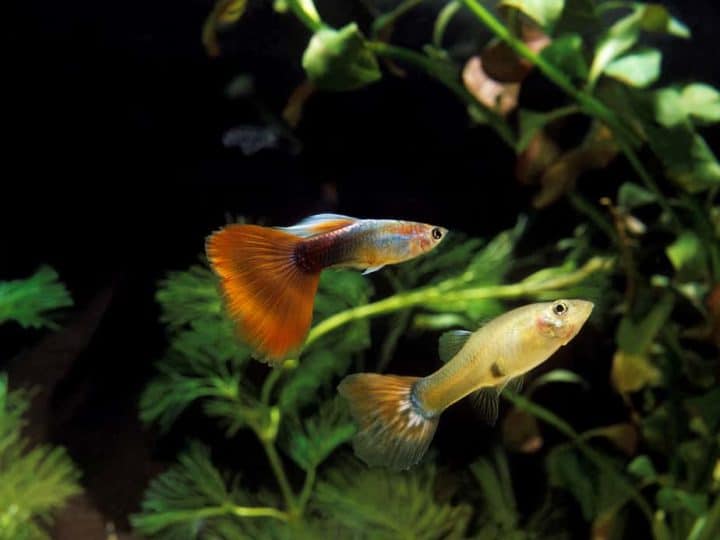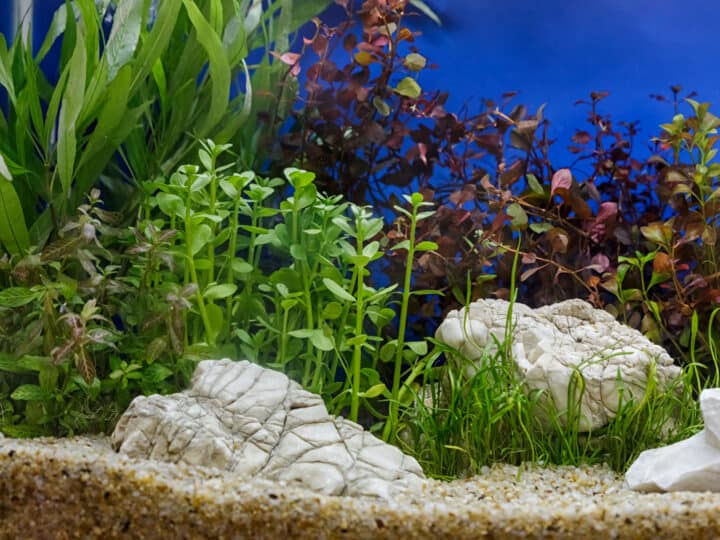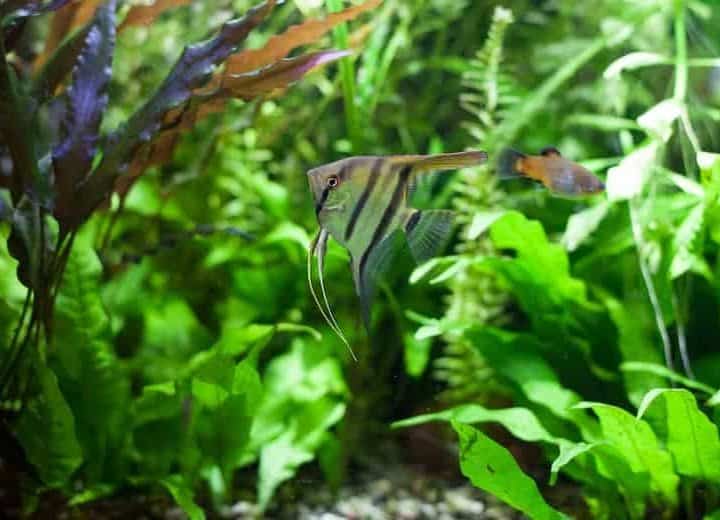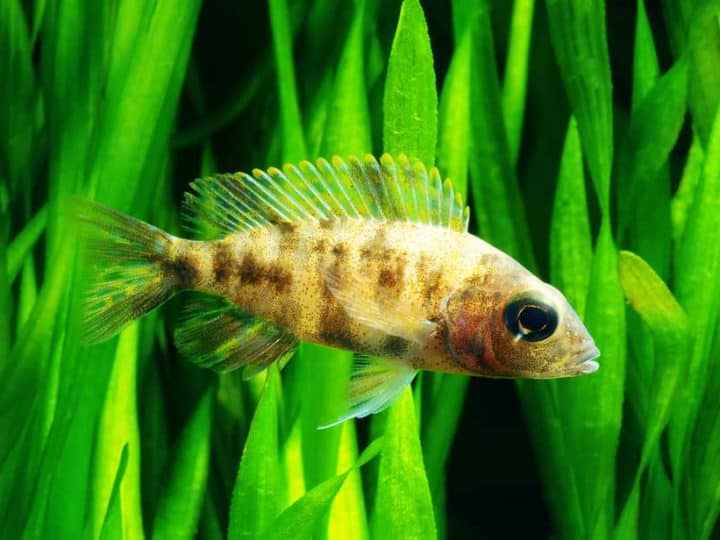Are you a cat owner who also loves aquariums? With the right plants, you can create an aquarium environment safe for your cats and fish.
Marimo moss balls, anubias, the java fern, Christmas moss, hornwort, water sprite, and the Calathea Leopardina (Calathea Concinna Freddie, Zebra Plant, or Prayer Plant) are all aquarium plants that are safe for cats.
In this blog post, we’ll explore the seven best aquarium plants that are safe for cats. These plants are easy to care for and provide a beautiful addition to your aquarium.
1) Marimo Moss Balls
Native to the cold, alkaline lakes of the northern hemisphere, Marimo Moss Balls are a unique and pet-friendly houseplant that doesn’t need much light (or anything else) to survive.
They can easily be kept in a clear container with filtered water and can even be added to aquariums or fish tanks for a fun aquatic experience.
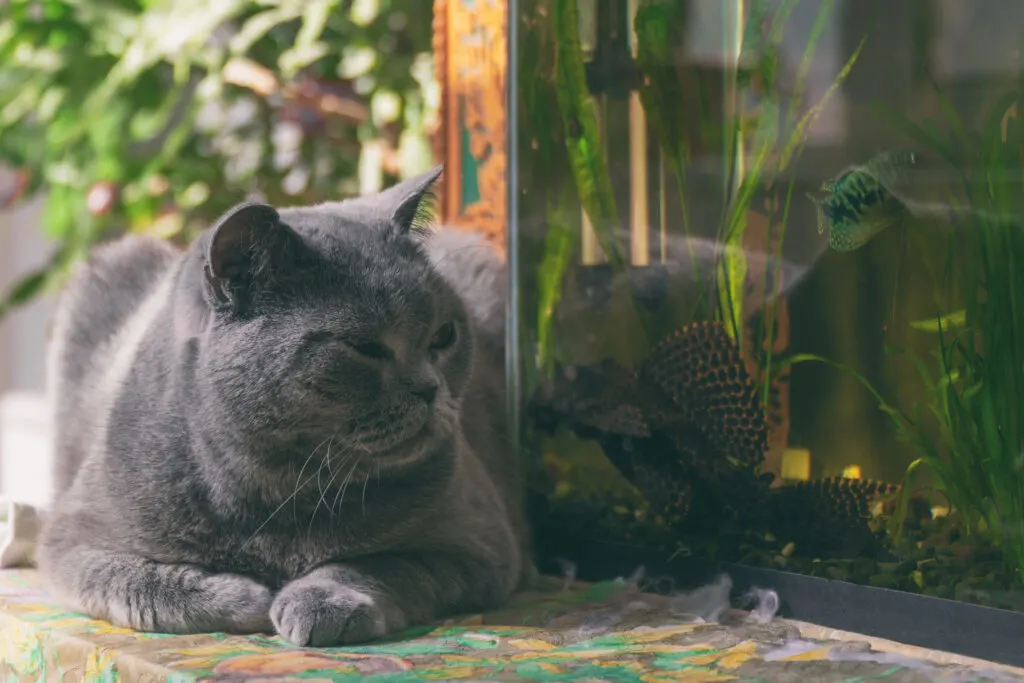
With Marimo Moss Balls, you won’t have to worry about your cats getting sick or poisoned, as they’re safe for them to play with or eat.
Plus, they don’t require any special care, making them an excellent choice for busy pet owners. And best of all, they’re relatively inexpensive and can be purchased online or at most pet stores.
So if you’re looking for a pet-friendly houseplant to add to your aquarium, Marimo Moss Balls are a great option!
They can be a great addition to any aquarium, providing a unique and exciting way to keep fish company. They can also offer supplemental filtration, making them doubly beneficial.
As with all pet-friendly plants, Marimo Moss Balls are safe for cats and won’t cause them any harm.
They don’t require special care, so you won’t need to worry about additional upkeep. With Marimo Moss Balls, you can add a beautiful, low-maintenance, pet-safe houseplant to your aquarium or fish tank with minimal effort.
2) Anubias
Anubias is an entire genus of plants, which includes several cultivars and varieties of the most common species, Anubias barteri.
Native to freshwater rivers and streams throughout tropical African regions, anubias typically attach themselves to surfaces like sunken logs, roots, or rocks along the riverbank.
Anubias can grow either emerged (with the leaves above the water line) or immersed (entirely underwater).
The plants grow from a central rhizome, and their roots mainly function to anchor the plant.
Anubias is relatively slow growing, with one new leaf every 1-4 weeks. The size of the tank and the species of anubias chosen will determine the placement of the plant.
Anubias prefers low lighting and should be given enough room to grow without being overshadowed by other plants in the aquarium.
This makes it an excellent choice for those looking to create a lush, low-light environment in their tank.
It is important to note that the common name “Anubias” refers to an entire genus of plants, not just one particular species.
Several cultivars and varieties of the most common species, Anubias barteri. Anubias is an excellent plant choice for cat owners, as it is easy to maintain and won’t cause any harm to cats that try to nibble on it.
It can also add a beautiful, lush look to your tank while providing plenty of hiding spots for fish and other aquatic creatures.
3) Java Fern
Java Fern is one of the most popular plants in planted aquariums. It is appreciated for its slow growth, unique leaf structure, and reproduction method.
Java Fern can tolerate most lighting conditions and many environments, from soft acidic water to alkaline conditions and even brackish tanks.
When planting Java Fern, you can float it in the tank, bury the roots in gravel, tie it onto a piece of wood, rock, or other décor, or use super glue gel.
Make sure not to bury the plant’s rhizome, as it needs to be exposed to light for photosynthesis.
One of the main advantages of this plant is that it does not require a substrate, making it ideal for bare-bottom tanks.
Java Fern will do best with a 6700k spectrum bulb but can survive with any range from low to medium-high light.
Surprisingly, Java Fern can live off very little light, even if forgotten in a bucket for several weeks.
Java Fern is a very low-maintenance plant that will spread slowly, giving your aquarium a unique look.
The plant is safe for cats, so there’s no need to worry if you have a curious kitty at home. With proper care and a little love, Java Fern will reward you with beautiful greenery for years.
4) Christmas Moss
Christmas Moss, or Vesicularia Montagnei, is a widely used plant in aquarium husbandry.
Named for its branches that hang down, overlapping each other to form the shape of a Christmas Tree, this moss is native to tropical Asia and can be found in Thailand, India, Japan, and the Philippines.
Its appearance is characterized by its round or oval-shaped leaves in a rich, dark green that terminates in a sharp point.
This plant thrives best in excellent, flowing water with a wide temperature range of between 65o to 77 degrees Fahrenheit.
This moss is an attractive addition to any freshwater aquarium when correctly cared for.
Christmas Moss is also known by its scientific name, Vesicularia Montagnei, and is a member of the Hypnaceae family.
When properly cared for, this moss is an attractive addition to any freshwater aquarium and can help create a lush and inviting space for you and your feline friends to enjoy.
5) Hornwort
Hornwort is a flowering aquatic plant that is identifiable by its unique, horn-like needles. It is used in many aquariums because it can beautify, oxygenate the water, provide cover for small fish and invertebrates, and clean the water.
Scientifically known as Ceratophyllum demersum, this aquatic plant is native to North America but has since spread to other continents.
Hornwort can be found in ponds, lakes, ditches, and quiet streams.
Hornwort thrives in slow-moving water- such as streams, marshes, ditches, lakes, ponds, and other wetlands/humid areas.
It is an undemanding plant that is resilient and cost-effective. Hornwort is an ideal aquarium plant for pet owners with cats, as it is non-toxic and can provide a safe and stimulating environment for both the fish and the cats.
Its unique, horn-like needles provide an exciting place for the cats to explore and relax.
Hornwort belongs to the Kingdom Plantae, Clade Tracheophytes, Clade Angiosperms, Order Ceratophyllales, Family Ceratophyllaceae, Genus Ceratophyllum, and Species Ceratophyllum demersum.
It is native to North America, though it has since spread to other continents.
It is found in ponds, lakes, ditches, and quiet streams in slow-moving water such as streams, marshes, ditches, lakes, ponds, and other wetlands/humid areas.
6) Water Sprite
The Water Sprite (Ceratopteris thalictroides) is a floating aquatic fern often used in aquariums to provide cover and shade for fish.
Native to tropical regions of the Americas, the Water Sprite has become popular in home aquariums as an oxygenator and attractive addition.
The Water Sprite has bright green feathery leaves with frilly edges and can grow up to 10 inches long.
They are best kept near the top of the tank, so it’s important to ensure you have adequate lighting for this plant.
You can expect the Water Sprite to spread quickly, so ensure there is plenty of room for it to grow.
Good tank mates for the Water Sprite include schooling fish such as tetras, guppies, and rasboras.
Fish to avoid include larger predatory species like angelfish, which may attempt to eat the delicate leaves.
Water Sprite should be fed a combination of liquid and solid fertilizers every few weeks. It’s also important to provide supplemental carbon dioxide to the tank since it needs plenty of CO2 to remain healthy and vibrant.
When caring for the Water Sprite, it’s crucial to maintain a planted tank environment with a pH of 6.5-7.5, GH between 3-8, and KH between 1-4.
It’s also essential to provide adequate filtration, oxygenation, and moderate water flow.
To maintain these parameters, weekly water changes should be performed, and dissolved organics should be tested regularly with an aquarium test kit.
Additionally, the tank should be monitored for signs of ill health, such as yellowing of leaves or discoloration of stems.
When setting up an aquarium for the Water Sprite, start with a layer of substrate topped with aquarium gravel or sand and fill it with dechlorinated water at the desired temperature range.
Then, add low-light plants and decorations to create hiding places for the Water Sprite.
To propagate the Water Sprite, simply snip off pieces of the stem with healthy new growth and replant them in another part of the aquarium.
With good care, you can expect your Water Sprite to thrive in your aquarium.
7) Calathea Leopardina
Calathea Leopardina, also known as Calathea Concinna Freddie, Zebra Plant, or Prayer Plant, is a perennial tropical member of the Arrowroot or Marantaceae family of plants.
It is a moderately sized plant, growing up to one foot tall and wide, with bold foliage that features deep green and lighter green zebra stripes.
Calathea Leopardina is an unusual aquarium plant since it does not require abundant water and prefers warm temperatures.
It likes partial shade and moderate to bright indirect lighting but not direct sunlight.
Fortunately, this plant is safe for cats and can be kept in a fish tank without causing harm to any pets or children in the household.
Calathea Leopardina is a unique and attractive plant for any aquarium, and its size and moderate water requirements make it an ideal choice for tanks of all sizes.
Not to mention, its non-toxic properties mean you don’t have to worry about it harming any cats, kids, or fish that may be around it!
Calathea Leopardina is a moderately sized plant, growing up to one foot tall and wide with bold foliage that features deep green and lighter green zebra stripes. Calathea Leopardina likes partial shade and moderate to bright indirect lighting, but not direct sunlight, and should be kept in a consistently warm setting ranging from 65-85 degrees Fahrenheit and with high humidity.

